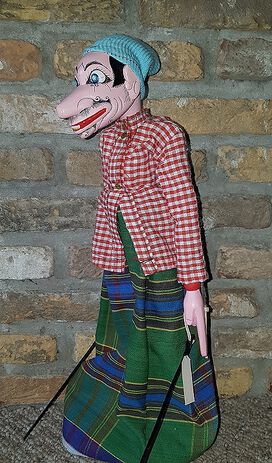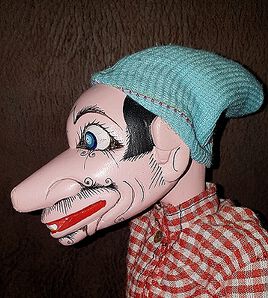Petruk
| Title | Petruk - (Panakawan) - All stories |
|---|---|
| Other names | Dawala, Udel, Kantongbolong, Suragendele, Tongtongsat, Durtawarna, Belgeduwelbel, Runggungjiwang |
| Size | 60 cm |
| Personal data | It is said that Petruk was the son of a giant priest named Begawan Salantara. His name is Pecruk Panyukilan. Petruk has a child named Lengkung Kusuma from his wife, Dewi Ambarwati, daughter of Prabu Ambarsraya. |
| Appearance | Petruk with faucet eyes (squinting), long nose, wide mouth, smiling lips. Petruk likes to joke around both in speech and behavior and he also likes to fight. He is powerful and likes to travel to test his powers. He has the physical characteristics of a long nose and black skin. Petruk has an ax weapon. |
| Collection | Private collection |
Petruk - (Panakawan) - All stories
Petruk is one of the Punokawan in Javanese wayang. It emerged because of the creation of Javanese poets. In Sundanese, he is better known as Dawala or Udel.
In the middle of his journey, Pecruk Penyukilan met a knight named Bambang Sukodadi. Because of the misunderstanding between them, a fight cannot be avoided. In this fight, neither of them lost or won, but instead their bodies and faces became disfigured and changed from their original forms.
Come, Batara Ismaya is the one who breaks them up. Both of them were adopted as children and served Sanghyang Ismaya. Bambang Pecruk Penyukilan's name is Petruk and Bambang Sukodadi's name is Gareng.
Petruk was once a king in Ngrangcangkencana, named Helgeduel-bek. His magic at that time was sourced from Kaliniahusada's letter, Pendawa's heirloom, which he had fled, after completing the play Mustakaweni. No one could defeat this king, not even a god, but by Gareng he was finally defeated, and the king returned to Petruk.
Petruk, Gareng and Semar never separated and always followed Arjuna and his descendants.
Petruk berwanda: 1. Jlegong, 2. Jamblang, these two poems are said to have been composed by Sri Sultan Agung in Mataram, 3. Mesem, 4. Dlonggop, and 6. Moblong.
Sometimes the knight's exit accompanied by the three servants, namely Semar, Gareng and Petruk, is preceded by a gara (which indicates the unsafe situation), in a scene where Gareng and Petruk pretend to be fighting by making insinuations at the audience and in general those who The girls were aimed at and if the two comedians' sarcasm hit the target, the girls would smile. In the past, sarcasm in this way was considered normal. Now it is considered as impolite.
It's hard for someone to be a mastermind. It's easy to get an unpleasant reaction from the audience, but you have to be able to accept it with a cool head, because the puppeteer must have the character of gending and gendeng, meaning he is proficient in gending (songs) and can follow the song with his voice. There are also those who say that the puppeteer must act like a comedian and have no shame, meaning that he dares to make a sound that makes the audience laugh, in which case the puppeteer must of course act as a comedian and must be good at jokes. Dalang can't be funny, it's generally disappointing.
Source: History of Wayang Purwa - Hardjowirogo - PN Balai Pustaka - 1982


